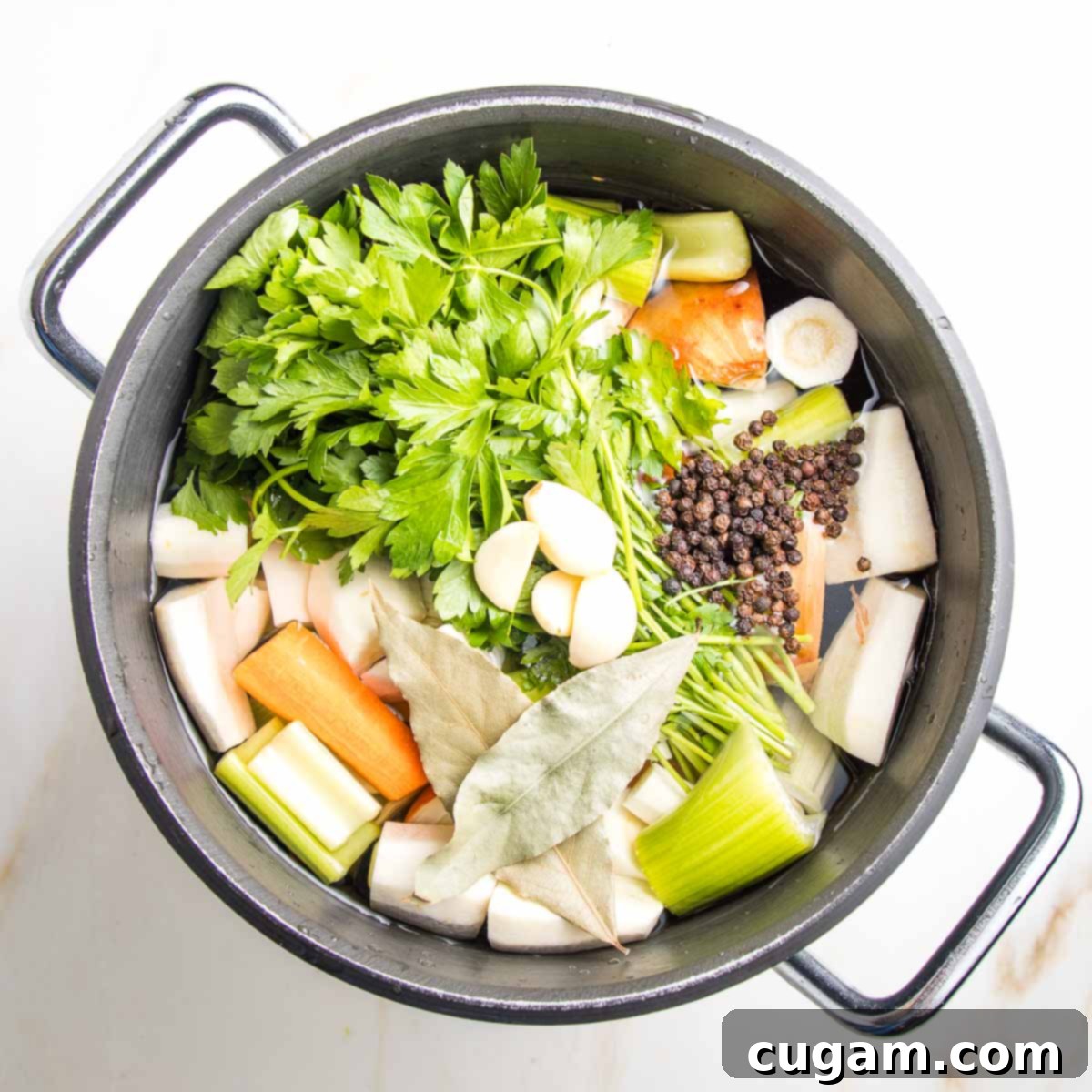Easy Homemade Vegetable Broth: Your Guide to a Healthy, Flavorful, and Budget-Friendly Kitchen Staple
Imagine a foundational ingredient that elevates nearly every savory dish you create. Something deeply flavorful, incredibly healthy, and surprisingly simple to make from scratch. That’s the magic of homemade vegetable broth! Forget those expensive, often overly-salted, and additive-laden store-bought cartons. Crafting your own vegetable stock is not only dramatically cheaper but also ensures you’re using only the freshest, most wholesome ingredients, making it far superior in both taste and nutritional value.
A good vegetable broth is truly a culinary staple, serving as the unsung hero in countless recipes. From nourishing healthy soups to the rich, savory foundations of most Thanksgiving recipes, its presence is felt in the depth and complexity it lends to your cooking. Once you experience the vibrant difference of homemade, you’ll wonder how you ever managed without this “liquid gold” on hand.
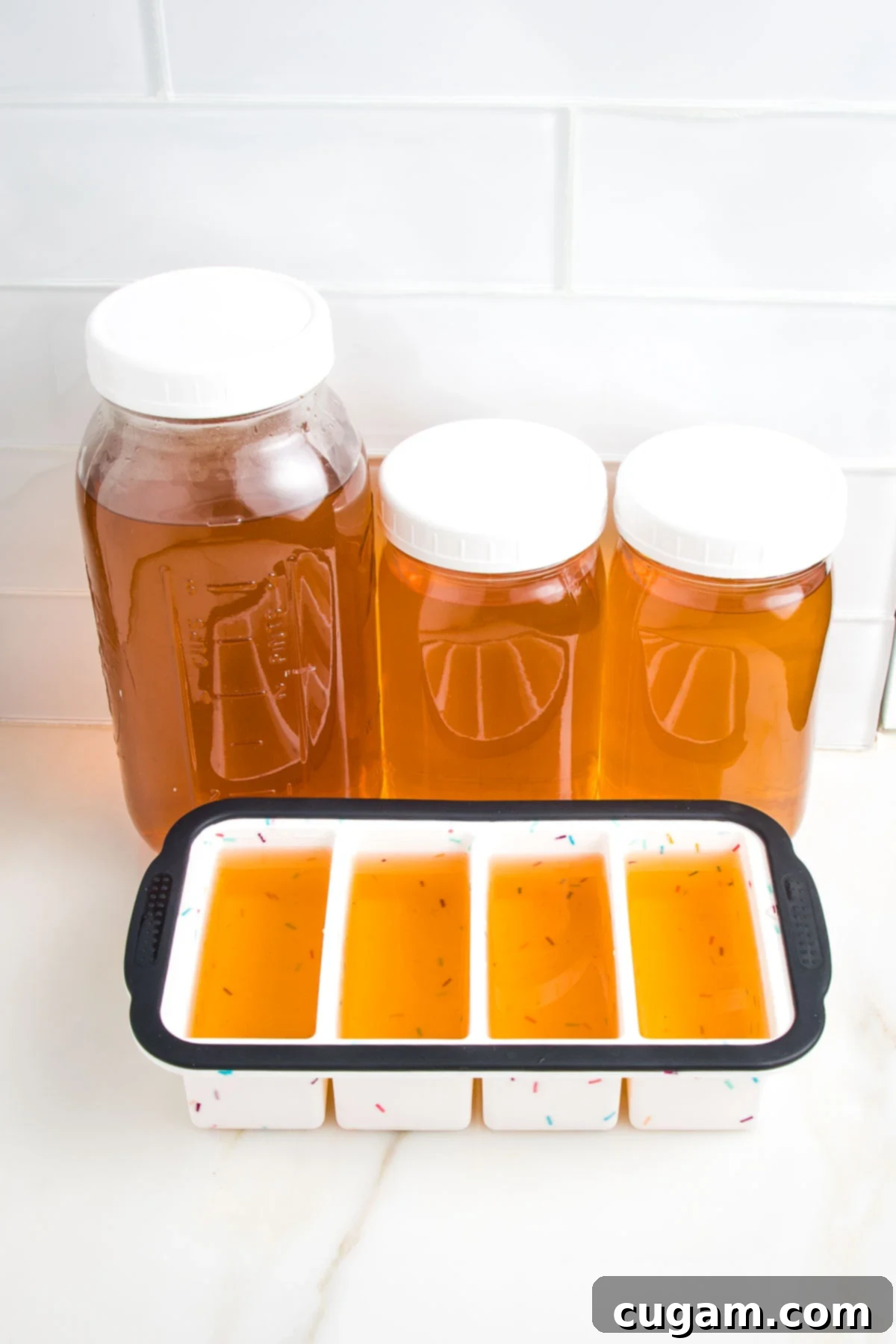
This comprehensive guide was updated from the original post, first published on January 11, 2016, to bring you even more tips and insights on mastering homemade vegetable broth.
Why Homemade Vegetable Broth is a Game-Changer
Having a steady supply of this simple, wholesome vegetable broth is an absolute must for any home cook looking to infuse their meals with authentic flavor and health benefits. You’ll find yourself reaching for it daily, not just for elaborate holiday feasts but for all your favorite soup recipes and countless everyday dishes that call for a robust veggie stock. Don’t be caught unprepared when a recipe demands this essential liquid; homemade is the definitive answer to a healthier, more economical, and undeniably tastier kitchen.
Trust me when I say this is hands down the best vegetable broth you’ll ever make. The moment you realize how effortlessly it comes together and the significant health advantages it offers, those generic, store-bought boxes will become a distant memory. I completely understand the allure of convenience; it’s tempting to grab a carton from the grocery store for that spontaneous weeknight soup. I used to be that last-minute soup maker, too, especially on chilly evenings when dinner plans were non-existent.
However, I consciously broke that expensive and often unhealthy habit, and I’ve never once regretted it. Now, my freezer is perpetually stocked with homemade veggie broth cubes, ensuring I’m always ready for any culinary adventure. The difference in freshness and depth of flavor is truly remarkable, transforming ordinary meals into something extraordinary with minimal effort.
The Problem with Store-Bought Bullion and Broth
Are you still relying on bullion cubes or highly processed broths? It’s worth taking a moment to consider what’s truly inside them. The ingredient lists often reveal a surprisingly high concentration of sodium, artificial flavors, and questionable additives like MSG (monosodium glutamate), inferior quality fats, artificial food coloring, and hydrolyzed soy or corn proteins. These hidden ingredients can subtly undermine your efforts to cook healthily and can mask the natural, delicate flavors of your dishes, leaving you with a less authentic taste experience.
The good news is, making your own no-sodium vegetable broth from scratch is incredibly simple, allowing you complete and total control over every single ingredient. This is particularly vital for those managing specific dietary requirements, such as a low-sodium diet, where every milligram counts. But what if you’re accustomed to the intense, quick-fix flavors of bullion? I’ve got you covered there too! My homemade vegetable bouillon powder recipe is a super easy and convenient alternative. You can whip up a flavorful broth from this powder in just one minute, offering the best of both worlds: ultimate convenience without any compromise on health or quality.
What is Vegetable Broth, Exactly?
At its core, vegetable broth is a flavorful liquid created by gently simmering an assortment of vegetables and aromatics in water. During this slow and steady cooking process, the vegetables gradually release their distinct flavors, vital nutrients, and often a beautiful golden hue into the liquid, creating a deeply aromatic and nourishing base. This rich infusion of goodness is precisely why a well-made veggie broth is often referred to as “liquid gold” in the culinary world – it truly is the indispensable foundation for countless delicious and healthy meals, providing a clean canvas for your culinary creations.
Unlike traditional meat-based stocks that rely on animal bones for gelatin and a rich body, vegetable broth derives its lusciousness and depth purely from the plant ingredients. This makes it a perfect choice for vegetarian, vegan, and plant-forward cooking, providing a clean, vibrant flavor that enhances, rather than overwhelms, other ingredients in your dish. It’s a pure and simple way to add complexity and nutrition to your cooking.
Essential Ingredients and Clever Substitutions
The beauty of homemade vegetable broth lies in its inherent flexibility. While a core set of ingredients forms the classic, well-rounded flavor profile, you have the freedom to experiment with what you have on hand, what’s in season, or what simply suits your taste preferences. Here’s a breakdown of the key players and their potential stand-ins to help you get started:
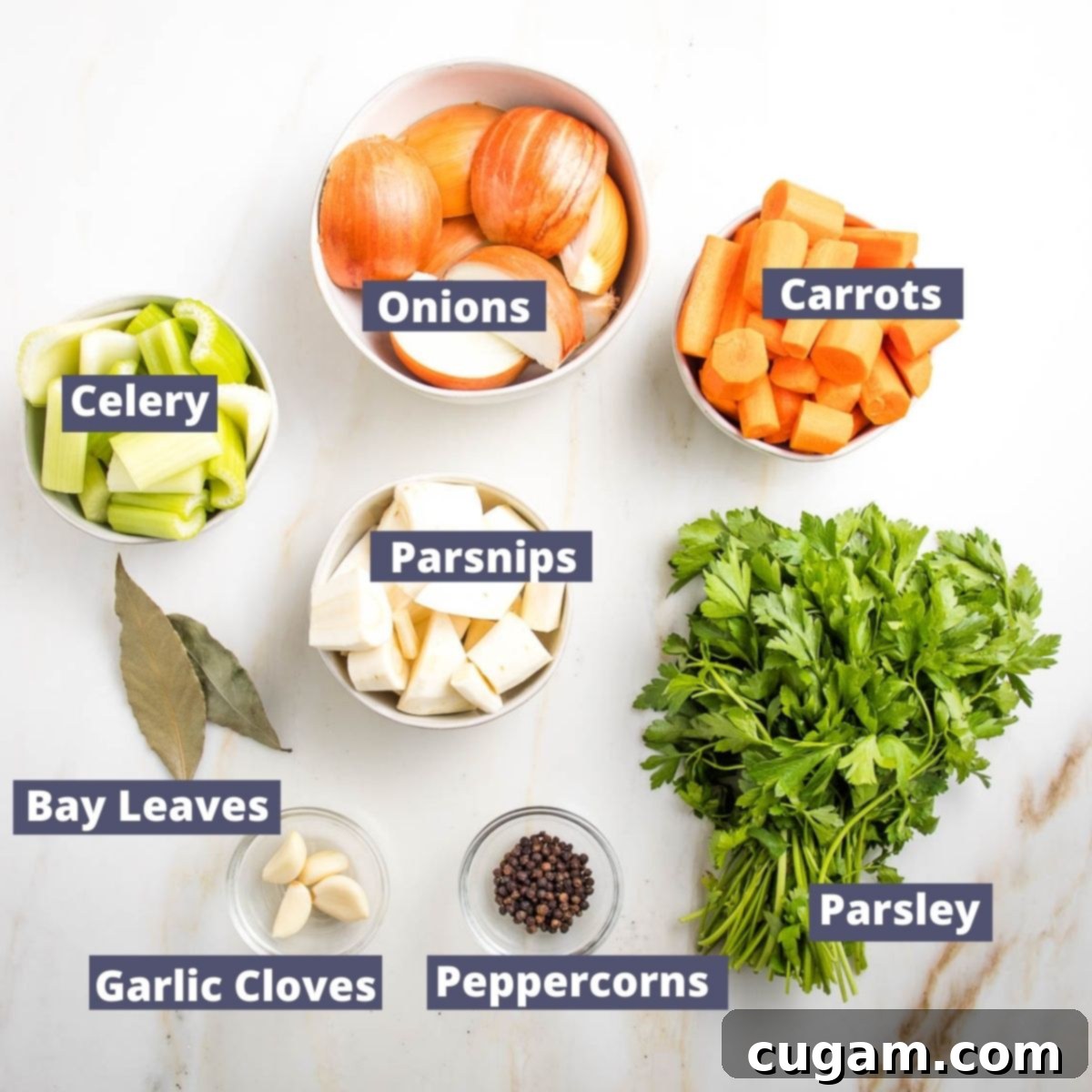
- Onions: The undisputed aromatic backbone of most broths, providing a subtle sweetness, umami, and depth. For variations, you can also use leeks for a milder, slightly sweeter onion flavor, or even a small amount of fennel for an intriguing, subtle anise note. Standard yellow or white onions work perfectly, and leaving their papery skins on can actually contribute to a deeper, more golden color in your finished broth.
- Carrots: These root vegetables are crucial; they contribute essential natural sweetness and a beautiful golden color to your stock. If you’re running low, sweet potatoes can offer a similar sweetness, though they will impart a slightly different, earthier flavor profile.
- Celery: An absolutely essential component for that classic aromatic base, providing a fresh, slightly peppery, and earthy note. Don’t discard the celery leaves – they are surprisingly flavorful and should absolutely be included for an extra boost of herbaceousness.
- Parsnips: Lend a wonderful earthy sweetness with a delicate hint of spice, adding complexity. Excellent substitutes include turnips for a slightly peppery earthiness or celeriac (celery root) for an intense, distinctive celery-like flavor that adds real character.
- Parsley: Nothing quite beats the fresh, vibrant, and earthy flavor of fresh parsley, especially the stems, which are packed with essential oils. If fresh isn’t readily available, you could always substitute fresh thyme or oregano, keeping in mind they will impart a slightly different, but equally pleasant, aromatic quality to your broth.
- Bay Leaves: These unassuming leaves are culinary powerhouses, adding a subtle, complex, and almost floral depth of flavor that rounds out the entire broth. Dried thyme is a decent substitute if you’re in a pinch, but a bay leaf truly adds that extra layer of sophistication and classic stock flavor.
- Garlic: A few whole, peeled cloves will infuse the broth with a pungent, savory aroma that is foundational to many cuisines. For a milder garlic essence, chives or garlic scapes can be substituted, offering a gentler, fresher taste.
- Whole Peppercorns: These provide a subtle, warming heat that is gently extracted and then strained out at the end, leaving behind a delicate, lingering spice rather than harshness. Whole pink or white peppercorns can be subbed for the black for a slightly different aromatic nuance and visual appeal.
- Water: While often overlooked, the quality of your water can significantly impact the final taste of your broth. Using filtered water will result in a cleaner, purer-tasting broth, allowing the nuanced vegetable flavors to truly shine without any off-notes from tap water impurities.
Customizing Your Broth: Flavor Variations
I always recommend starting with the basic recipe above, especially when preparing a large batch of broth for general use and freezing. A “generic” or neutral vegetable broth is incredibly versatile and serves as an excellent foundation for any dish. However, if you have a specific culinary creation in mind, don’t hesitate to embellish your basic vegetable stock with additional ingredients to create unique, tailored flavor profiles. Here are some ideas to inspire your culinary experiments:
- ASIAN-Inspired Broth: To create a broth perfect for stir-fries, ramen, or pho, add fresh ginger slices (no need to peel, just wash thoroughly), a handful of dried shiitake mushrooms for a deep umami boost, and some green onions (scallions) for a delicate, fresh oniony kick. A splash of soy sauce or tamari can be added after straining for more specific seasoning.
- MEXICAN-Inspired Broth: For a broth that sings in enchilada sauces, bean dishes, or tortilla soup, incorporate a few ripe tomatoes (halved) for a touch of acidity and sweetness, and one or two whole jalapeño or serrano peppers (you can leave them whole for mild heat or slice them for more intensity). Cumin seeds can also add an authentic touch.
- SWEET & EARTHY Broth: To achieve a uniquely sweet and rich broth that beautifully complements autumnal dishes, roasted vegetables, or even some dessert-adjacent savory recipes, introduce chunks of sweet potato, butternut squash, or even a couple of cored apples or pears. These add a natural fructose sweetness and a lovely body.
- OTHER Neutral Additions: For an expanded basic broth that’s still broadly applicable, consider including zucchini, yellow summer squash, asparagus ends (though not the bitter woody parts), or even regular potatoes. These add to the body and nutrient content without significantly altering the core flavor profile, but should be used sparingly to avoid making the broth starchy.
AVOID: While many vegetables are wonderful when cooked directly into soups, some can unexpectedly overpower or discolor your broth during the simmering process. Strongly flavored or colored vegetables like beets (which will instantly turn your broth a vibrant, sometimes undesirable, red!), purple carrots, rutabagas, cabbage, cauliflower, broccoli, Brussels sprouts, and most leafy greens (like kale or spinach) are generally not ideal for a basic broth. Their robust and often sulfurous flavors can become bitter or unpleasant when simmered for an extended period, and cruciferous vegetables can create a distinctly pungent, sulfuric aroma that might not be what you’re aiming for. These vegetables are perfectly fine and delicious to add *into* a soup or stew that uses your finished stock as a base, but they are best skipped when making the foundational broth itself.
Need Veggie Broth in a Hurry? Try Bouillon Powder!
Sometimes, even the most dedicated home cooks find themselves in a pinch, needing vegetable broth on the fly without time for a full simmer. But convenience doesn’t have to come at the cost of chemicals or compromised health! If you find yourself needing vegetable broth in a hurry, my homemade vegan bouillon powder recipe is your ultimate, secret-weapon solution.
This fantastic bouillon powder uses simple, recognizable, whole-food ingredients that you can trust, giving you complete control over the amount of salt (or other seasonings) you add – or omit entirely, which is a huge benefit for dietary control. It boasts an impressively long shelf life, making it a brilliant pantry staple that’s always ready when you are. And here’s the best part: just add hot water, and you can transform this concentrated, flavorful bouillon powder into a rich, aromatic vegetable broth in literally one minute! It’s perfectly designed for quick gravies, deglazing pans when sautéing vegetables, boosting the flavor of rice and other grains, or creating an instant cup of soothing broth without having to thaw a frozen cube. It’s the ultimate smart shortcut for healthy, flavorful cooking.
How to Make Vegetable Broth from Scratch: A Step-by-Step Guide
Making homemade vegetable broth is an incredibly rewarding process, and surprisingly hands-off. Once you’ve gathered your ingredients, most of the work involves passive simmering. Follow these simple, detailed steps for a perfect batch every time:
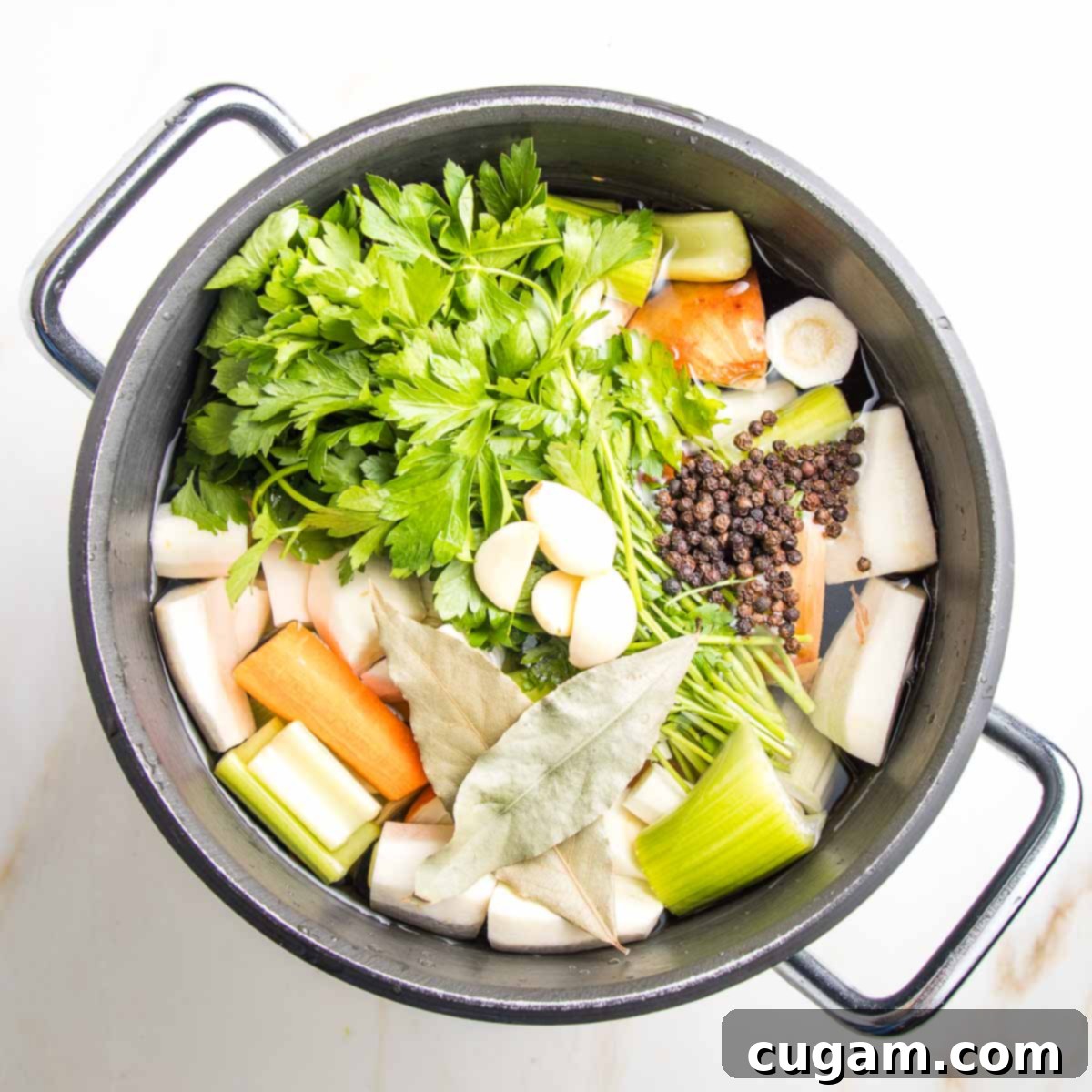
Step 1: Gather & Prep Your Veggies. Begin by washing all your vegetables thoroughly. As you prep each one, add it directly into a large stock pot. Roughly chop the onions into quarters (leaving the skins on if you prefer a more intensely colored, amber broth – the skins contain natural dyes!). Peel (or simply scrub clean with a vegetable brush or loofah) the carrots and parsnips, then roughly chop them into large, manageable pieces – there’s no need for precision as they will be strained out later. Clean and trim the celery, then roughly chop it, making sure to include any leafy tops for an extra burst of herbaceous flavor. Peel the garlic cloves, but leave them whole. Rinse the parsley, keeping the stems attached, as they contribute significant flavor. This combination forms the foundational aromatic base of your rich, homemade broth.
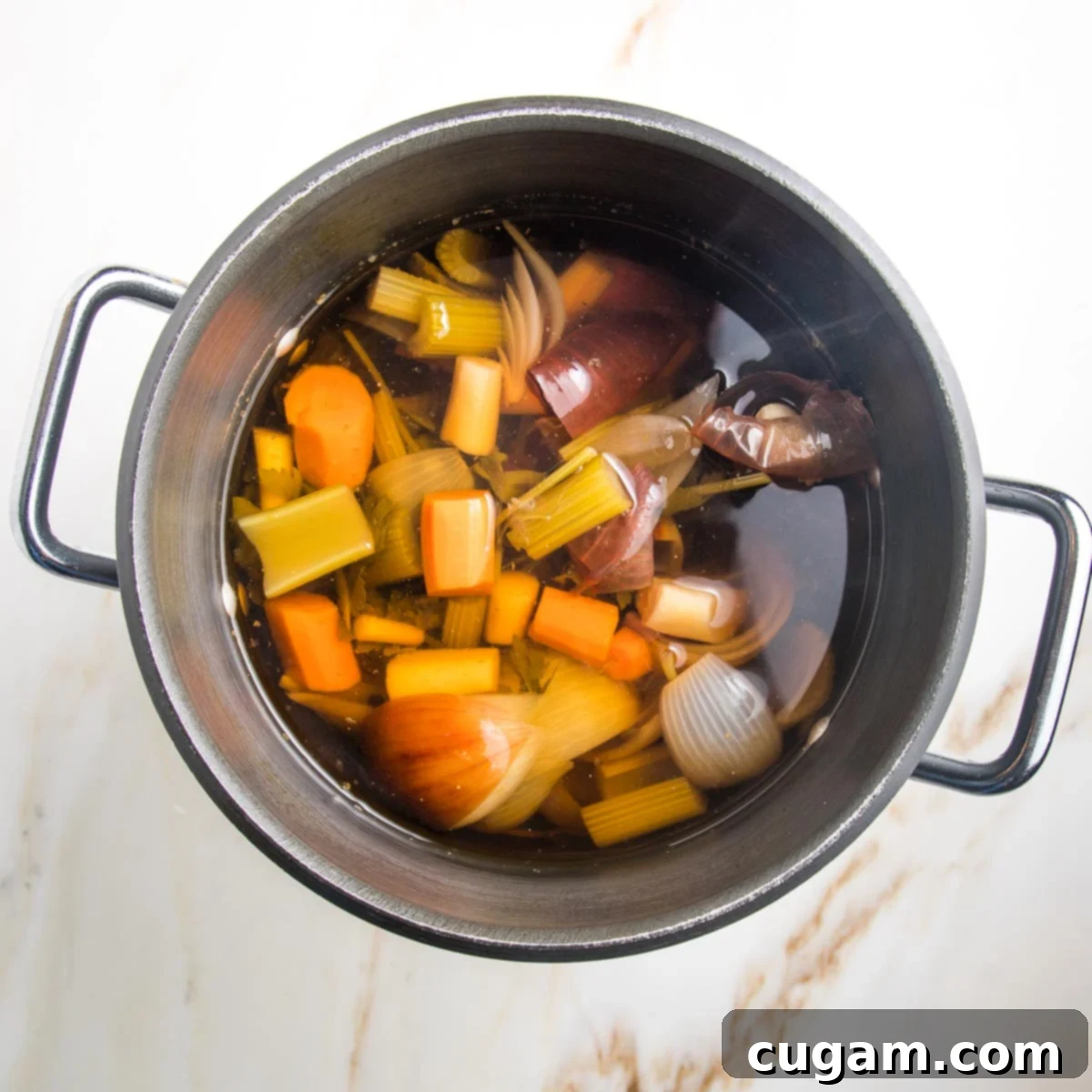
Step 2: Simmer to Perfection. Once all your prepared vegetables are in the pot, cover them generously with filtered water, ensuring they are fully submerged by at least an inch or two. Add the bay leaves and whole peppercorns. Place the pot over medium-high heat and bring the mixture to a rolling boil. As soon as it’s actively boiling, reduce the heat significantly to maintain a gentle, consistent simmer. Allow it to cook, uncovered, for approximately 45 minutes to one hour. Simmering uncovered is important as it allows for some water evaporation, which helps to concentrate and intensify the flavors of your “liquid gold.” Avoid boiling too vigorously, as this can agitate the vegetables and lead to a cloudy broth.
Step 3: Strain and Cool. When the vegetable broth has simmered sufficiently, has developed its rich aroma, and taken on a beautiful golden color, carefully remove the pot from the heat. Place a colander (or for an extra-clear broth, a fine-mesh sieve lined with cheesecloth) over another large heatproof bowl or pot. Carefully pour the contents of your stock pot through the colander, separating the cooked vegetables from the flavorful liquid. All the wonderful nutrients and flavor compounds will have transferred to the broth. Allow the strained broth to cool completely at room temperature before transferring it into your chosen storage containers. Rapid cooling is important for food safety; you can speed this up by placing the pot in an ice bath.
Optional: Repurpose Cooked Vegetables. The cooked vegetables, having given up most of their flavor to the broth, are typically composted or discarded. However, if you’re aiming for a creamy, nourishing soup that minimizes food waste, you can absolutely repurpose them! Simply discard the bay leaves, peppercorns, and any woody parsley stems that might be too fibrous. Then, puree the remaining cooked vegetables until smooth using an immersion blender or a regular blender. Stir this velvety puree back into your strained stock, mix well, and season to taste with a pinch of salt if desired. This creates a wonderfully thick, satisfying, and delicious soup that’s incredibly wholesome.
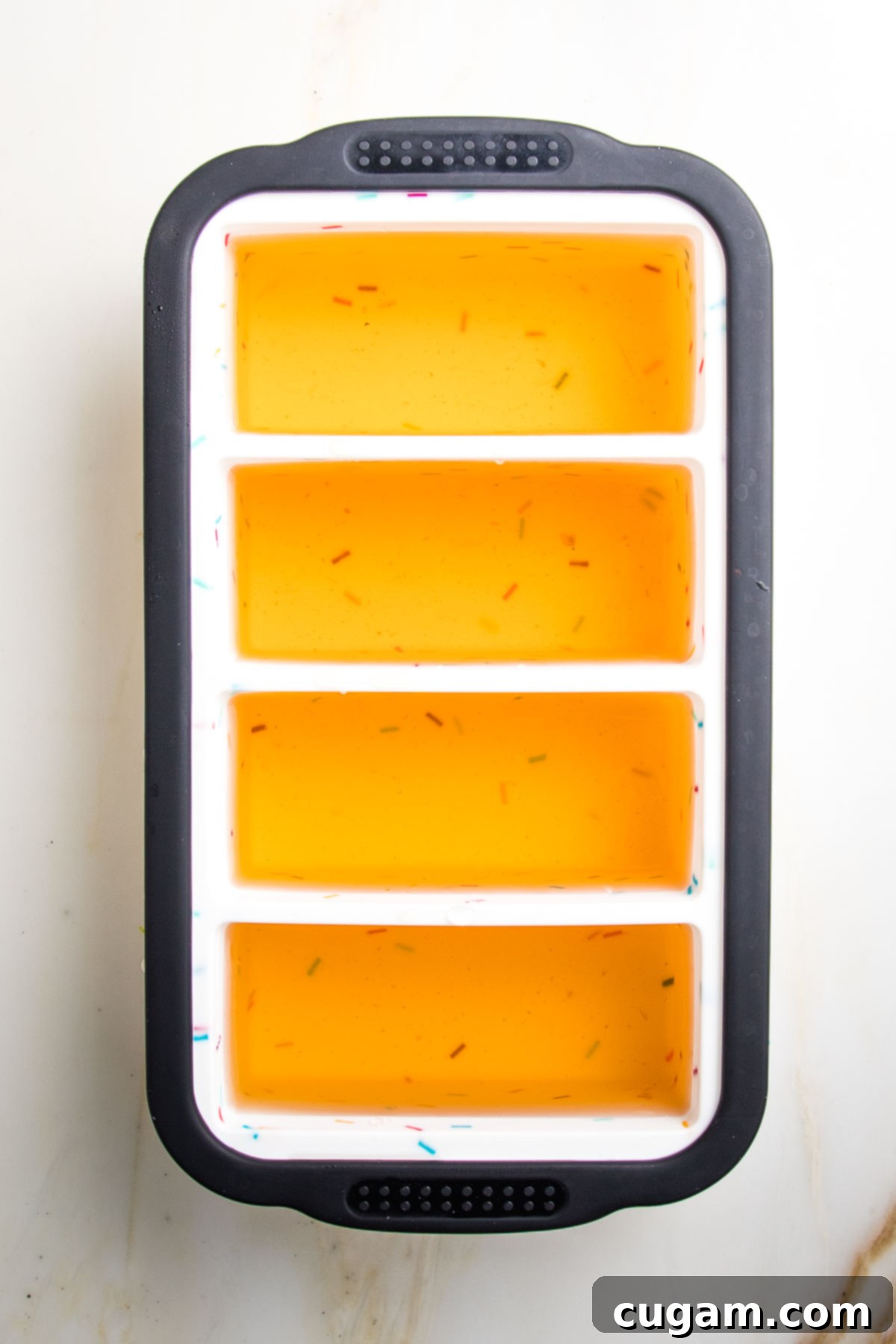
Storage Solutions for Maximum Convenience: I find it incredibly convenient and efficient to freeze homemade vegetable broth in various sizes to perfectly suit my future cooking needs. For everyday use and smaller quantities, freezing in 1-cup portions using durable silicone molds (like Souper Cubes) is an absolute game-changer. Once completely frozen solid, simply pop out the perfectly portioned cubes and transfer them to a freezer-safe zip-top bag. This method offers super convenient storage that doesn’t take up excessive freezer space and makes thawing a breeze. For larger quantities needed for big soup pots or braises, quart-sized freezer containers or even wide-mouthed glass jars work beautifully. Remember a crucial tip: leave about an inch (2.5 cm) of headspace in glass jars to account for the liquid’s expansion during freezing; this prevents the glass from cracking. Properly stored, your homemade liquid gold will keep fresh and flavorful in the freezer for up to 3 months.
The Undeniable Advantages of Making Your Own Vegetable Broth
- Budget-Friendly: This is one of the most compelling and practical reasons! You can easily make 3 quarts (the equivalent of 3 standard store-bought cartons) of richly flavored veggie broth for significantly less than the cost of buying just one box at the grocery store. It’s an incredible way to stretch your food budget while simultaneously eating healthier and more deliciously.
- Rich, Authentic Flavor: When you use only whole, fresh, real food ingredients, the natural, vibrant taste shines through beautifully, creating a depth of flavor that artificial alternatives can’t replicate. There’s absolutely no need for artificial flavor enhancers, high-sodium additives, or synthetic ingredients. You have the ultimate freedom to add more (or less) of your preferred vegetables and herbs, and you can even simmer it down longer to concentrate the flavors for an even richer, more intense broth if that’s the robust taste you’re looking for.
- Incredibly Nourishing & Transparent: Say goodbye to unwanted and often hidden additives like MSG, artificial preservatives, inflammatory processed vegetable oils, and excessive amounts of hidden salt. Homemade broth offers complete transparency, allowing you to control every single ingredient that goes into your body. This means you can tailor it perfectly to suit various dietary needs and restrictions. Following a low FODMAP diet? Simply omit the high-FODMAP ingredients like onions and garlic, and compensate with more carrots, celery, and suitable herbs. It’s pure, clean nourishment you can trust.
- Unbeatable Convenience & Customization: Yes, you read that right – homemade can be even more convenient than store-bought! When you make a batch from scratch, you gain complete control over how to store it, allowing you to perfectly suit YOUR unique lifestyle and cooking habits. If you consistently need 6 cups for a particular family-favorite recipe, freeze it in convenient 6-cup increments. If you’re sautéing without oil and just need a splash here and there to deglaze a pan or prevent sticking, freeze tiny portions (e.g., in 1-tablespoon ice cube trays). This way, you pull out precisely what you need, minimizing waste and maximizing efficiency in the kitchen.
- Control Over Sodium (The Ultimate No-Salt Option): Finding truly no-sodium vegetable broth in stores is incredibly difficult, if not virtually impossible, as most commercial brands use salt as a primary flavor enhancer. For those on a low-sodium diet, or simply trying to reduce their overall salt intake for health reasons, homemade no-salt vegetable stock is an absolute game-changer. You add the salt (or not) exactly when and how you want it, giving you ultimate dietary control and ensuring your meals are perfectly balanced to your preference.
What’s the Difference Between Stock and Broth? A Brief Clarification
The terms “vegetable stock” and “vegetable broth” are very often used interchangeably in recipes and everyday conversation, and for most home cooks, it’s perfectly fine to substitute one for the other without issue. In fact, you’ll see me use both terms throughout many of my soup recipes, indicating that either is acceptable for the desired outcome and that the distinction is less critical in a plant-based context.
Historically, the primary distinction between “stock” and “broth” largely revolved around animal products: traditional stock was typically made from simmering animal bones (like chicken, beef, or fish bones) to extract gelatin and collagen, which gives it a richer body, mouthfeel, and sometimes a thicker consistency when cooled. Broth, on the other hand, was generally made from simmering meat and vegetables and was often seasoned, making it lighter and typically suitable for sipping on its own.
In the realm of vegan or vegetarian cooking, where animal bones are not involved, the lines blur even further, and the terms become almost synonymous. However, here are a few nuanced points that some culinary purists might still consider:
- Seasoning: Broth is traditionally seasoned during its cooking process, meaning it’s ready to drink or use as is. Stock, conversely, is typically unseasoned or minimally seasoned, meant to be a neutral base that will be seasoned later within a recipe. This is where the concept of “no-salt” vegetable stock often comes into play, as it offers maximum flexibility for seasoning your final dish precisely.
- Purpose: Some culinary purists might argue that broth is primarily something you might sip directly, perhaps for comfort or health, while stock is fundamentally intended as a foundational ingredient for cooking and building complex flavors in other dishes. However, a well-made vegetable stock can certainly be enjoyed on its own!
- Vegan Context: For plant-based cooking, many chefs and home cooks consider the terms virtually synonymous because the defining characteristic of animal bones (and their gelatin content) is entirely absent. Therefore, a vegan stock is, by nature and composition, essentially a vegetable broth.
Having said all that, don’t get too caught up in the technical terminology. My ultimate encouragement is simple: make a wonderful pot of gently simmered vegetables, strain the rich liquid, and then confidently use that incredibly flavorful liquid for any recipe that calls for either “vegetable stock” or “vegetable broth.” Your taste buds (and your health) will undoubtedly thank you for the homemade goodness!
Debra’s Pro Tips for the Best Broth
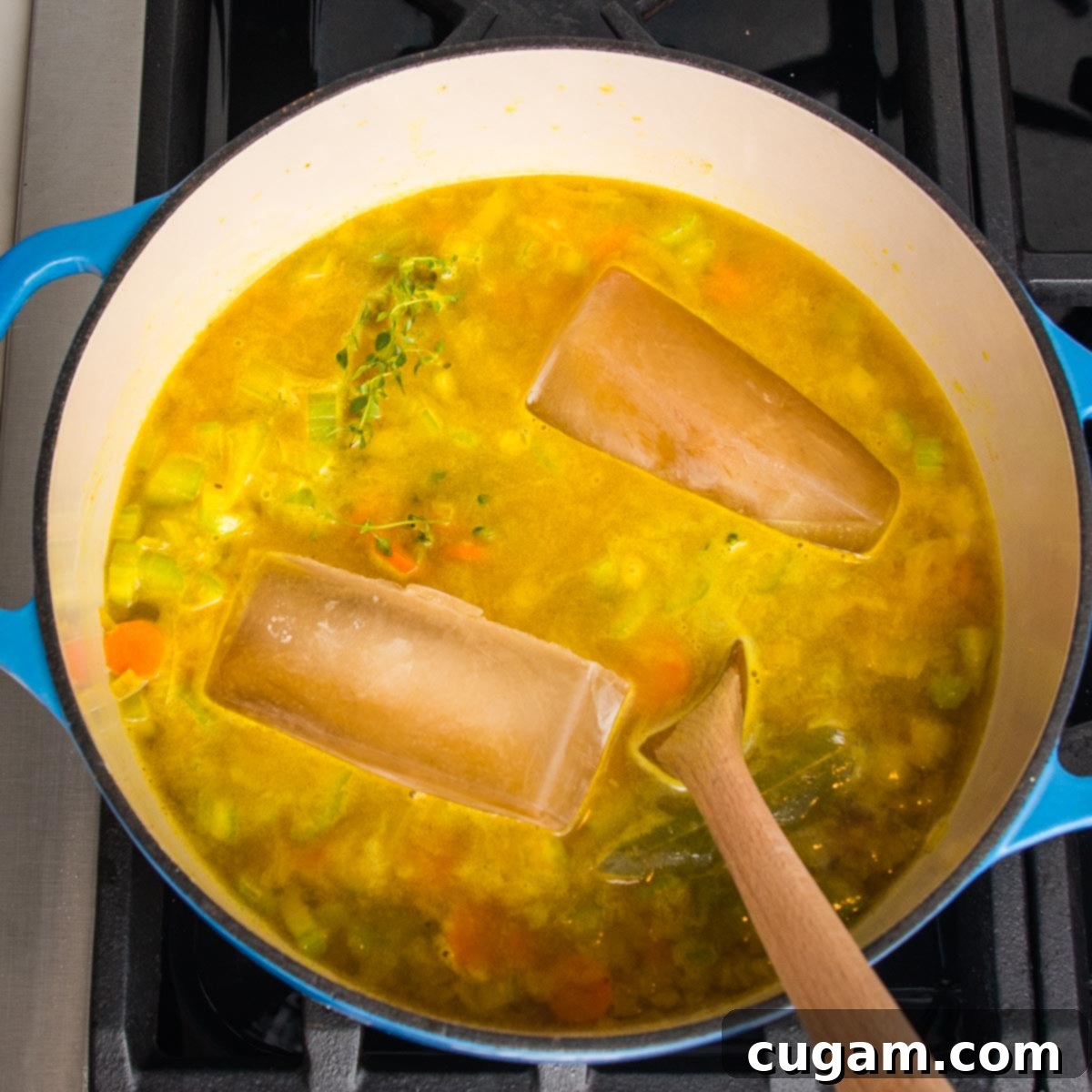
- Embrace Your Scraps: This is my favorite tip for maximizing flavor and minimizing food waste! Keep a dedicated freezer-safe bag or container in your freezer specifically for vegetable scraps. As you trim carrots, onions (including the papery skins for a deeper color!), celery, mushrooms, parsley stems, and other non-bitter vegetable trimmings, toss them into this “scrap bag.” When you’re ready to make a fresh batch of veggie broth, add the contents of this bag to your pot for an incredible, added layer of complex, deep flavor. Just be mindful to avoid strong cruciferous vegetable scraps like broccoli, cabbage, or Brussels sprouts, as they can sometimes turn your broth bitter or give it an unpleasant aroma.
- Freeze in Various Sizes: To ensure you always have the right amount of broth for any recipe, tailor your frozen portions to your typical cooking needs. Freeze larger amounts (e.g., 2-4 cups) in containers for making a big pot of soup or stew, and freeze smaller amounts (e.g., 1/2 cup or even 1 tablespoon in regular ice cube trays) for quick deglazing of pans, adding to grains like rice or quinoa, or boosting a sauce. These small vegetable stock cubes are super convenient and eliminate waste!
- Direct from Freezer to Pot: Don’t feel obligated to wait for your broth cubes or frozen portions to defrost before using them. You can toss frozen veggie broth cubes or blocks directly into your pot of soup, sauce, or stew. They will melt quickly and seamlessly integrate into whatever you’re making, saving you precious time and effort.
- Quality Freezer Bags: If you’re using zip-top bags for storage (either for individual cubes or larger flat portions), make sure they are specifically labeled as “freezer grade.” These bags are thicker and more resistant to freezer burn, which will help protect your homemade broth’s fresh flavor and quality over time.
- Allow for Expansion: This is a crucial step for safe and successful freezing! Always remember that liquid expands significantly when it freezes. If you’re using glass jars (which I highly recommend for sustainability and ease of use), be absolutely sure to leave at least an inch (2.5 cm) of headspace at the top of the jar. This vital space allows for expansion and prevents your glass jars from cracking in the freezer.
- Adjust Seasoning Thoughtfully: If you’re accustomed to the intense, often high-sodium flavor of store-bought stock, your palate might need a moment to adjust to the clean, natural taste of no-salt homemade vegetable broth. More importantly, always keep this in mind when following recipes that call for broth or stock – they typically assume a salted product. Therefore, it’s always best practice to taste your final dish *before* adding any extra salt, and then adjust the seasonings according to your preference. This empowers you to control the sodium in your meals perfectly and achieve the exact flavor balance you desire.
- Don’t Over-Simmer: While a long, slow simmer is excellent for extracting deep flavors, over-simmering vegetable broth (much beyond 1-1.5 hours) can sometimes lead to a slightly bitter or muted taste, especially if you have delicate or sensitive vegetables in the mix. Stick to the recommended time for optimal, vibrant results.
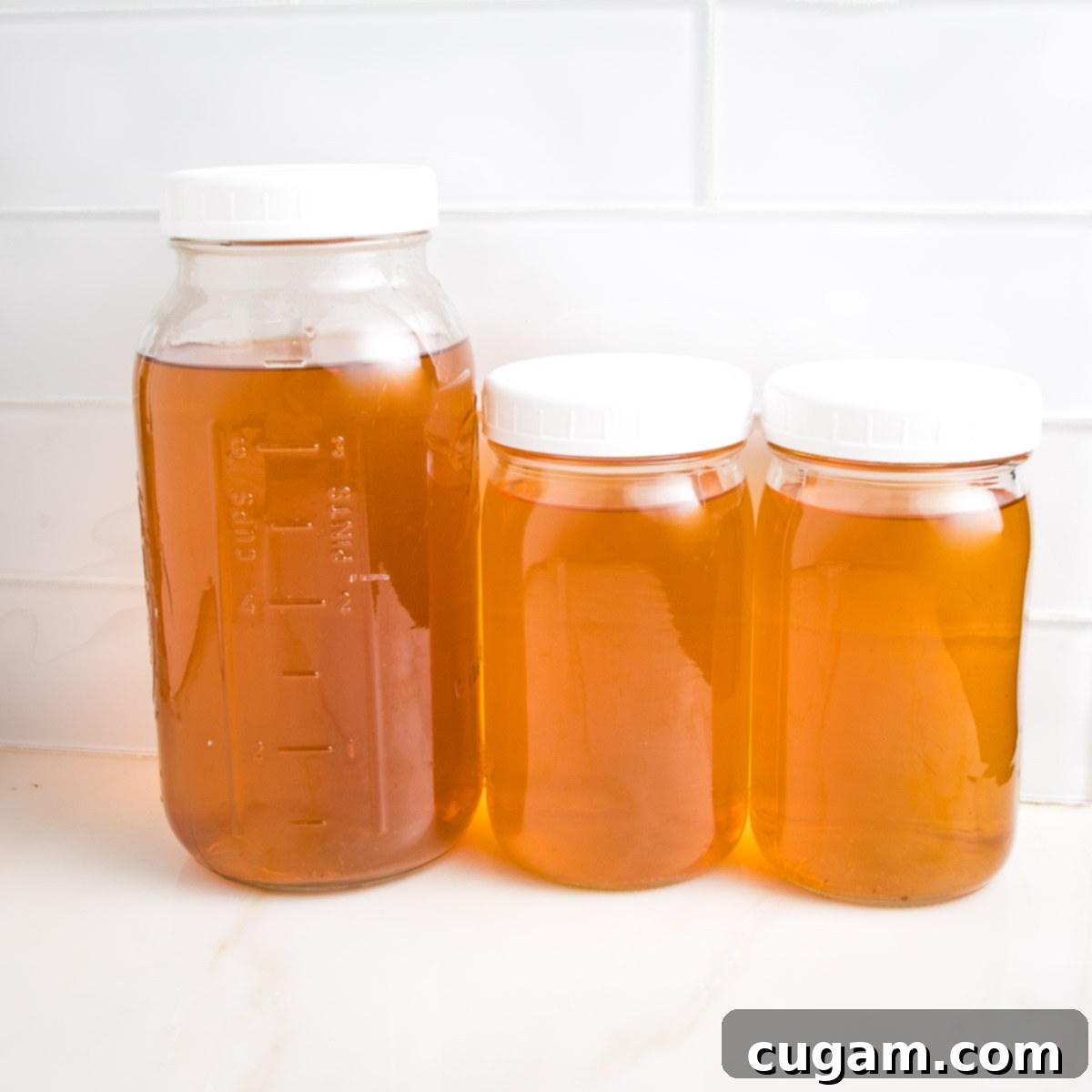
Recipes That Sing with Homemade Vegetable Broth
Once you have a batch of this delicious, healthy homemade vegetable broth on hand, you’ll be amazed at how many recipes it can transform from good to absolutely extraordinary. Its clean, vibrant, and customizable flavor makes it the perfect base and liquid component for a wide array of dishes:
- Vegan Mushroom Stroganoff Recipe
- Easy Vegan Gravy Recipe
- Homemade Red Enchilada Sauce
- Gluten-free Cornbread Stuffing
From rich, savory sauces and hearty gravies to comforting stews, creamy risottos, and elegant braised vegetables, this homemade broth provides a depth of flavor that store-bought options simply cannot match. It’s also an excellent choice for cooking grains like quinoa, couscous, or rice, infusing them with an extra layer of savory goodness instead of plain water. Elevate your culinary game by incorporating this versatile staple into your daily cooking!
Did you know commenting and rating recipes is one of the best ways to support your favorite food bloggers? If you made this recipe, please consider a five-star rating below and leave a comment sharing your experience. Also, please share your beautiful photos on Instagram by tagging me @dkhealthcoach and using the hashtag #debraklein. Your valuable feedback, kind comments, and shares truly make a significant difference and are deeply appreciated!
📖 Recipe
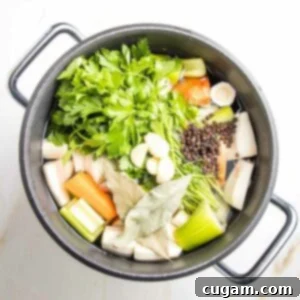
Vegetable Stock
Rate this Recipe
Pin Recipe
Equipment
-
Souper Cubes Silicone Freezer Tray
-
Stainless Steel Stock Pot/Stockpot
Ingredients
- 2 onions
- 4 large carrots
- 3 parsnips
- 3 stalks celery
- 4 cloves garlic peeled
- 1 bunch parsley
- 2 bay leaves
- 1 Tablespoon peppercorns
- 5 quarts water
Instructions
-
PREPARE THE VEGGIES: Begin by washing all your vegetables thoroughly. As you prep each one, add it directly into a large stock pot. Quarter the onions; you can leave the skins on if you prefer a more intensely colored, amber broth – the skins contain natural dyes! Peel (or simply scrub clean with a vegetable brush or loofah) the carrots and parsnips, then roughly chop them into large, manageable pieces – there’s no need for precision as they will be strained out later. Clean and trim the celery, then roughly chop it, making sure to include any leafy tops for an extra burst of herbaceous flavor. Peel the garlic cloves, but leave them whole. Rinse the parsley, keeping the stems attached, as they contribute significant flavor. This combination forms the foundational aromatic base of your rich, homemade broth.
-
ADD WATER AND AROMATICS: Pour in 5 quarts (which is equivalent to 20 cups) of filtered water over the vegetables, ensuring they are more than fully covered. Add the bay leaves and whole peppercorns to the pot, distributing them evenly amongst the vegetables.
-
BOIL AND SIMMER: Place the pot over medium-high heat and bring the mixture to a full, rolling boil. As soon as it’s actively boiling, reduce the heat significantly to maintain a gentle, consistent simmer. Allow it to simmer, uncovered, for a period of 45 minutes to one hour. Simmering uncovered is important as it allows for some water evaporation, which helps to concentrate and intensify the flavors of your “liquid gold.” Avoid boiling too vigorously, as this can agitate the vegetables and lead to a cloudy broth.
-
STRAIN THE BROTH: Once the simmering time is complete, carefully remove the pot from the heat. Place a fine-mesh colander (or for an extra-clear broth, a colander lined with cheesecloth) over another large heatproof bowl or pot. Carefully pour the contents of your stock pot through the colander, separating the cooked vegetables from the flavorful liquid. Discard the cooked vegetables, or set them aside if you plan to repurpose them as described in the optional step above.
-
COOL AND STORE IN FRIDGE: Allow the strained veggie stock to cool completely to room temperature before transferring it into covered containers. This is crucial for food safety. You can speed up the cooling process by placing the pot in an ice bath. Once cooled, it will remain fresh and delicious in the refrigerator for up to a week.
-
FREEZE FOR LONG-TERM STORAGE: For longer storage, freeze your broth! You can freeze it in quart-sized containers for easy access when making a large pot of soup. Alternatively, freeze it in ice cube trays (and then pop the frozen cubes into freezer-safe zip-top bags once solid) so you can easily defrost small amounts as needed. These small cubes are perfect when a pan is dry and you don’t want to add additional oil, or for adding a boost of flavor to grains. Homemade broth can be stored in the freezer for up to 3 months, ensuring you always have it on hand.
Notes
Nutrition
Note
The nutrition calculations were done using online tools. To obtain the most accurate representation of the nutritional information in any given recipe, you should calculate the nutritional information with the actual ingredients you used. You are ultimately responsible for ensuring that any nutritional information is accurate, complete and useful.
